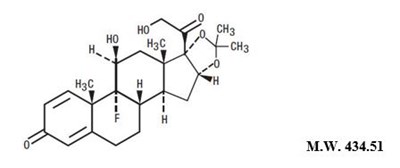FDA Label for Triamcinolone Acetonide
View Indications, Usage & Precautions
Triamcinolone Acetonide Product Label
The following document was submitted to the FDA by the labeler of this product Quagen Pharmaceuticals Llc. The document includes published materials associated whith this product with the essential scientific information about this product as well as other prescribing information. Product labels may durg indications and usage, generic names, contraindications, active ingredients, strength dosage, routes of administration, appearance, warnings, inactive ingredients, etc.
Description
Triamcinolone Acetonide Lotion, USP is supplied in the following strengths: 0.025%, 0.1%. Each mL of Triamcinolone Acetonide Lotion, USP, 0.025%, 0.1% contains 0.25 mg, 1 mg triamcinolone acetonide, USP in a lotion base containing citric acid, cetyl alcohol, dimethicone, polysorbate 20, propylene glycol, purified water, sorbitan monopalmitate, and stearyl alcohol. It may contain 10% citric acid solution or 10% sodium citrate solution for pH adjustment.
Triamcinolone Acetonide is a topical corticosteroid known chemically as 9-Fluoro-11β, 16α, 17, 21-tetrahydroxypregna-1,4-diene-3,20-dione cyclic 16,17-acetal with acetone.
The molecular formula is C24H31FO6. It has the following structure:
Clinical Pharmacology
Topical corticosteroids share anti-inflammatory, anti-pruritic and vasoconstrictive actions.
The mechanism of anti-inflammatory activity of the topical corticosteroids is unclear. Various laboratory methods, including vasoconstrictor assays, are used to compare and predict potencies and/or clinical efficacies of the topical corticosteroids. There is some evidence to suggest that a recognizable correlation exists between vasoconstrictor potency and therapeutic efficacy in man.
Indications And Usage
Topical corticosteroids are indicated for the relief of the inflammatory and pruritic manifestations of corticosteroid-responsive dermatoses.
Contraindications
Topical corticosteroids are contraindicated in those patients with a history of hypersensitivity to any of the components of the preparation.
Adverse Reactions
The following local adverse reactions are reported infrequently with topical corticosteroids, but may occur more frequently with the use of occlusive dressings. These reactions are listed in an approximate decreasing order of occurrence:
| Burning | Perioral dermatitis |
| Itching | Allergic contact dermatitis |
| Irritation | Maceration of the skin |
| Dryness | Secondary infection |
| Folliculitis | Skin Atrophy |
| Hypertrichosis | Striae |
| Acneiform eruptions | Miliaria |
| Hypopigmentation |
Overdosage
Topically applied corticosteroids can be absorbed in sufficient amounts to produce systemic effects (See PRECAUTIONS).
Dosage And Administration
Topical corticosteroids are generally applied to the affected area as a thin film from three to four times daily depending on the severity of the condition.
Occlusive dressings may be used for the management of psoriasis or recalcitrant conditions.
If an infection develops, the use of occlusive dressings should be discontinued and appropriate antimicrobial therapy instituted.
How Supplied
Triamcinolone Acetonide Lotion, USP 0.025% is supplied in the following size: 60 mL. (NDC 70752-129-05).
Triamcinolone Acetonide Lotion, USP 0.1% is supplied in the following size: 60 mL. (NDC 70752-130-05).
Store at 20° to 25°C (68° to 77°F) [see USP Controlled Room Temperature].
AVOID FREEZING
SHAKE WELL BEFORE USING
* Please review the disclaimer below.
